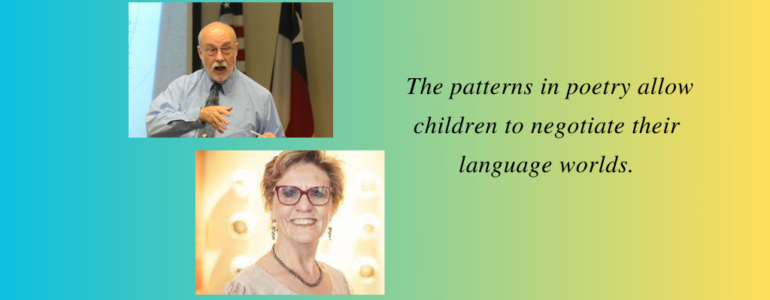By Timothy Rasinski and Lois Letchford
In a previous posting on the Robb Review (9.12.2020), I (Tim) described how much poetry has to offer for the teaching of reading. It is an engaging, joyous reading, and it offers opportunities to develop essential reading competencies in students. However, one of the most significant attributes of poetry is its ability to improve the reading outcomes of children identified as dyslexic or learning disabled and, indeed all children who struggle to become proficient readers.
The brevity of most poetry for children as well as the rhythmical, melodic, and rhyming patterns in poetry (and songs) allow even the most struggling of readers to achieve success. Research tells us that human beings have what appears to be an innate ability to detect patterns in our environment. Seeing patterns allows us to better negotiate our worlds. The patterns in poetry allow children to negotiate their language worlds. All of us know young children who have learned to recite the words to a familiar rhyme or song. While memorizing the lines of poetry and songs is not reading per se, giving children visual access to the written words in those poems and songs can be a beginning step to reading.
Several years ago, I met an amazing woman named Lois Letchford. She had just written a book entitled Reversed which described the journey that she and her dyslexic son Nicholas who went from “learning disabled” to a skilled reader, and highly successful adult. Writing and using poetry was one major transformative component of our literacy story.
Lois’ Story:
In 1994, my son Nicholas went into first grade. He failed. Throughout this year, he bit his fingernails, wet his pants, and stared into space. At the end of the year, standardized testing sealed expectations revealing he could read ten words, displayed no strengths, and had a “low IQ.”
I had the opportunity to homeschool Nicholas for six short months, hoping for a turn-around. Armed with a book series labeled, “Success for All,” I too, failed. Stress levels skyrocketed, and progress remained at zero.
It was my mother-in-law who came to my rescue, offering simple yet profound advice: “Lois, put away what isn’t working and make learning fun.” Her words compelled me to reevaluate my approach to this daunting challenge. But where should I begin? Where did Nicholas excel? Her advice encouraged me to rethink and redesign my approach. But what could I do? What could Nicholas do?
I recalled Nicholas and I previously working with spelling patterns. He could do that. He recognized the patterns and learned all those words. How could I use this strength?
I thought about rhyming words and how to use them. Could I write a short poem to help Nicholas? When desperation reigns, one can only try to find solutions.
I wrote one simple poem and read it to Nicholas. We read it together and found the rhyming words. That first poem titled A Mug of a Bug, was a huge success. He relaxed and recalled it. He was engaged, we talked about the meaning, found the rhyming words, and recited the poem.
One poem led to the next and the next. Each poem added to his knowledge, enjoyment, and purpose for reading and writing. My first poems focused on words with short vowel sounds. Poems then include our travel experiences. One poem was about visits to the thousand-year-old church of St. Nicholas. The memory I treasure is one of Nicholas running ahead of his Grandma to visit it, shouting, “Nana, Nana! They named this church after me!” Connections were growing.
Nicholas’s reading growth appeared slow, each poem seemingly added just a drop into the ocean of required literacy knowledge. Yet, in a poem using the “oo” words as in ‘cook, look, and book,’ I wrote about the last of the great explorers, Captain James Cook. My poem:
Captain Cook had a notion there was a gap in the map in the great big ocean.
He took a look, without the help of any book, hoping to find a quiet little nook.
Captain Cook had a notion there was a gap in the map in the great big ocean,
He took a long look, and filled a whole book which caused the whole world to look!
Poetry is simple. Ideas embedded in poetry were extraordinary. The exploration of this poem tapped into Nicholas’ curiosity, resulting in his asking questions I could not answer.
“Who came before Captain Cook?” was his first question.
“Oh,” I replied, “that’s easy. That was Christopher Columbus.”
“And who came before Columbus?” He shot back.
And I was stunned. It was not a question I had ever considered. His question turned me into a curiosity-driven researcher determined to find answers to his questions.
Though Nicholas’s knowledge of letters and sounds had grown slowly, his intellectual curiosity was boundless.
Why was poetry such a powerful tool for Nicholas’s learning?
Prof Sansislas Deheane’s book How We Learn has a chapter on the four pillars of learning. These pillars are Attention, Active Engagement, Error Feedback, and finally, Consolidation.
Every day, I had Nicholas’s attention. He was actively engaged in listening, reading, and responding to details of all poems. Poetry was building his knowledge base, providing a purpose for using those challenging letters and sounds and building an understanding of patterns in language. Finally, the consolidation through repetition by reading, writing, and reciting these poems aided growth.
It took almost 25 years to appreciate the impact of this foundational knowledge. In 2018, Nicholas defied the odds and completed his PhD in Applied Mathematics from Oxford University.
As for me, my book Reversed: A Memoir tells the longer literacy journey from failure to academic success.
![]()













